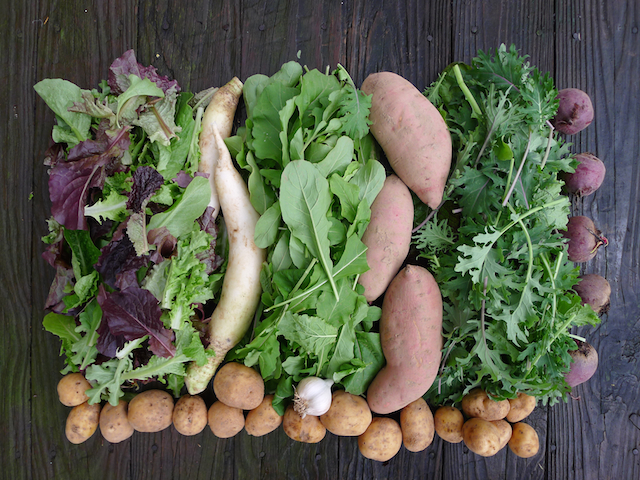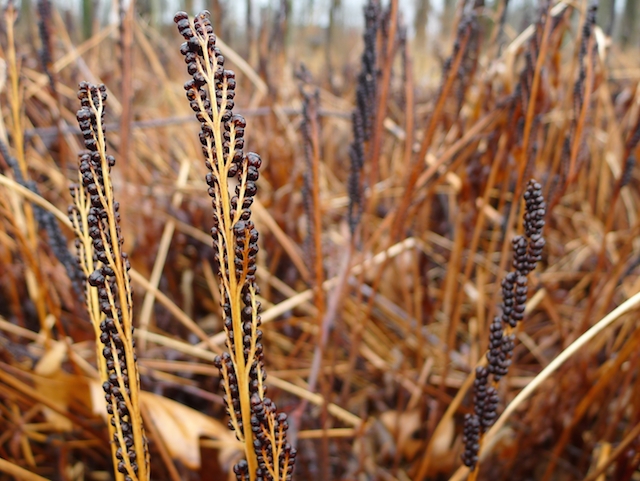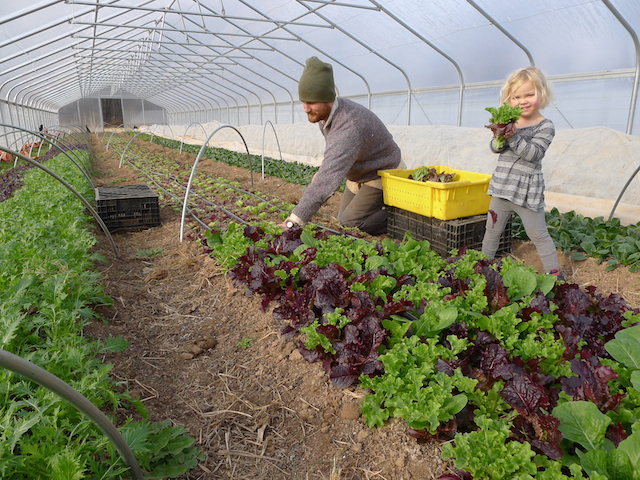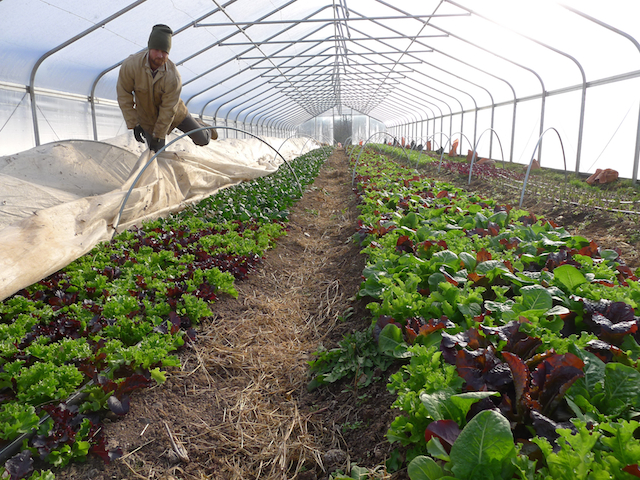
Late Fall CSA Week 5: Winter Solstice Upon Us
News
Expected Harvest
Greens and Roots in Balance
by Farmer Dana
Greens and Roots in Balance
by Farmer Dana

Late Fall harvest #5 (Week A) should include sweet potatoes, daikon radishes, rutabaga, beets, potatoes, mini cabbage, lettuce mix, garlic, greens/kale mix, and arugula. Some items will be a choice.

Important Pick Up Information
by Farmer Dana
by Farmer Dana

Spore stalk on a species of fern found along the edge of the woods south of Field 1 in a wet meadow.
This is a reminder that during Late Fall CSA harvest week #6 (Week B) pick up days are Thursday 12/27 1-8pm (instead of Wednesday) and Saturday 12/29 11am-12noon. E-mail us if you need to switch your pick up day.

Notes From The Field
So Long, Autumn
by Farmer Derek
So Long, Autumn
by Farmer Derek

Harvesting some wonderful lettuce mix with a great little helper.
We welcome the Winter Solstice this week as seasons switch from autumn to winter. The darkest day of the year will come and go and then we'll appreciate lengthening days during the coldest time of the year. Fast forward to February when daylight eclipses the 10-hour mark and we'll be thinking spring, but for now we'll enjoy the holiday season and longer slumbers.
Besides spreading compost for a couple days this past week while the ground was dry and hard enough, I attended a Pennsylvania Association of Sustainable Agriculture (PASA) event that brought together advanced growers from the region to reflect on this past season. Much was mentioned of the calamitous nature of Mother Nature this year, it being one of the wettest or the wettest on record, and how the excessive moisture affected various crops and yield. Farmers are a relatively resilient group, with this season being perhaps the toughest test yet for this cohort of advanced growers who have anywhere from 10 to 30 years of growing experience. Most growers there were from small family owned produce farms or businesses that predominantly sell directly to consumers through a CSA or farmers market. Many also sell produce to restaurants and wholesale. Most farm organically and many are certified organic.
In addition to the beneficial feeling of camaraderie that surrounds this similar group that shared many of the same struggles during this season, I wanted to be able to leave the meeting with some valid insights into ways to improve our farm as we move forward into less predictable and more extreme weather. There are many factors that affect crop health but soil type probably has the greatest influence during a wet year. Soils that drain more quickly performed better than those that do not. Size of an operation also seemed to determine outcomes. Bigger producers and growers who require more time for field work and rely solely on mechanical/machine means for field preparation and cultivation struggled to stay on schedule. Crops couldn't be planted and those that got in were quickly outcompeted by weeds. Conversely, farmers who manage a smaller land area, focus on efficiencies, have diverse crops, and try to maintain output rather than continually expand seemed to weather the weather slightly better this year. Many growers mentioned the desire of scaling back to achieve a higher level of efficiency and control.
So what about our little CSA-only farm? Overall this year I think we held up okay. Our worst season for growing was the fall. It was an extremely wet time period but also unfortunately most of our plantings were concentrated in areas of the farm that have soil that doesn't drain that well (we have at least three soil types on the farm). Some crops grew well there including leeks, beets, later plantings of hakurei turnips, endive, dandelion, and lettuce mix. Crops that underperformed there included broccoli, cauliflower, cabbage, and Brussels sprouts. Spring and summer weather was almost as wet as the fall but the sun and heat helped crops through. Warm wet weather is much better than cold wet weather for our crops. Certain yields were down enough that warranted cancellation of the Winter CSA in order to make sure we had enough produce for the final month of the Main Season as well as the entirety of Late Fall. Good performers this season included strawberries, raspberries, blackberries, peas, heirloom and hybrid tomatoes, sweet peppers, summer carrots, cucumbers, zucchini, sweet potatoes, beets, onions, and garlic.
Because next year we won't be able to control the weather any better than this year we'll continue to do the little things that have allowed our operation to overall succeed during extreme weather events. We'll also consider investing in big capital and infrastructure improvements for longterm stability. We'll continue to embrace farming efficiently by maintaining our current membership size so that our land footprint remains consistent. Importantly, we'll prepare our fields for growing by taking advantage of dry weather windows to give us planting space for the next 3 or 4 weeks of planting (in case the soil remains unworkable for that long). We'll make raised beds so plants don't drown. We'll maintain or enhance crop diversity. We'll cultivate using manual means such as the omnipotent oscillating wheel hoe. We'll handweed when absolutely necessary with the help of our membership. We'll address drainage issues by slightly adjusting bed slope so water flows out of the field. We'll add contour buffer strips, waterways, and diversions to thwart a deluge. We'll sow cover crops whenever possible to minimize erosion. Additional longterm investments will be made with the construction of high tunnels.
This year was full of extreme rainfall events. It might be an anomaly, it might not be. We'll be ready for next season no matter what. Thank you for your support (and sorry this note is so long, I am guilty of overthinking)!

How I Enjoyed My Harvest
Healthy Greens
By Linda Dansbury
Healthy Greens
By Linda Dansbury

Uncovering lettuce mix and spinach in the hoop tunnel.
I grew up eating salads almost every night, so for me I feel better and healthier if I consistently eat them. We take the Italian approach to salad eating and enjoy it at the end of the meal - the reasoning behind this is it aids in digestion but another thought process is if you eat a salad at the start of the meal you will eat less of the main course.
Either way, enjoying salads, especially at this time of year helps you get the nutrients you need to stay healthy. Add ingredients such as honey roasted almonds or pecans; dried cranberries; fresh figs and pears; or roasted beets. Also consider using a nut oil such as walnut. All of these additions change an every day salad into a special holiday dish!
We have been enjoying the spinach immensely! The Spinach Salad with Warm Bacon Dressing has become a weekly enjoyment - we have a simple piece of fish to keep the meal lighter. I also decided to make Creamed Spinach with our pastured, grass fed rib eye. Made with fresh spinach and just a bit of cream make this a delicious side dish - and when I didn't have quite enough spinach for the dish, I added in some of the greens mix - I wasn't sure how it would be, but I really enjoyed the added flavor.

Join the 2019 Main Season
by Farmer Derek
by Farmer Derek

Wishing for better weather for an easier growing season in 2019!
Log in here to sign up for the 2019 Main Season CSA. Share prices remain the same for next year. We do the bulk of farm purchasing during the winter months and it is very helpful to have members sign up and pay for shares in advance. A $200 deposit finalizes the sign up process. Total membership will remain the same as the past five seasons and we continue to fill up year after year (thankfully). We'll be in touch over the winter months with highlights, anticipations, and improvements we hope to make for next season. Since the weather cannot possibly be as bad as it was in 2018, everything is sure to be better!


